Antarctica
2009
| |||||||||||||||||||||||||||||||||||||||||||||||||
| |||||||||||||||||||||||||||||||||||||||||||||||||
| |||||||||||||||||||||||||||||||||||||||||||||||||
2 November 2009
The past few days I've been trying to recover from a cold while sleeping in a tent and commuting to work in an open-air vehicle. Cold notwithstanding, I think this would add undue stress to the average person who does not feel well. My day off made me feel quite a bit better in fairly fast order, but my one day back at work yesterday has set me back again. In this environment, even when I think I'm getting used to it, my body reminds me that it's more complicated than just thinking you're ok.
Regardless, work marches on, and so do the seasons, even in Antarctica. Even though we have only been in the field a week, the increase in temperature in that time has been obvious. The afternoon temperature here has been in the mid-20s the last couple of days, which has been a pleasant change from zero. This was probably most noticeable to me, however, on our commute to work yesterday morning. Within a mere day off the dynamic of this trip had definitely changed.
I haven't spent much time, previous to this trip, travelling around in vehicles on ice. For most of my life, if this Texan was driving over ice two things were likely true:
- Just prior to getting in the car, I had gone completely insane.
- I was wildly out of control and headed sideways for the nearest telephone pole.
Many of you non-Texans reading this are nodding and laughing, and while the scientific evidence may still be lacking to back up your opinion of the average Texan's ability to drive on ice, science will back up that the fact that the temperature is just barely below freezing on any given "ice day" in Texas is contributing to the slickness of the ice. So far our daily commute here has been much like any other daily commute in a six-wheeled ATV, which many of you may be making elsewhere (!). It so happens that our road to work is a smooth sheet of ice, but driving on it has been much like driving on a road at home. As the weather gets warmer, though, this ice gets warmer, and yesterday, the friction of driving on it was able to create just enough water to make it noticeably more slippery. We spent the whole drive fishtailing, the finale being a near 180-degree spin when it came time for Chris to make the turn off the moat ice into the rougher ice of the center of the lake to head to the bot house.

A scenic shot of our moat ice right outside East Bonney Camp. It has large cracks like the one seen here, which make the ride a little bumpy, but not really problematic otherwise.
This may sound like great fun to many of you, but my long history of fishtailing and donuting into fence posts, Suburbans, and moving 18-wheelers has made me gun-shy. I could probably eventually let go and enjoy a nice 180 on a smooth ice road like above, but running right along side us the entire trip is the rough ice that covers most of the lake, and hitting that sideways at speed would probably result in rolling the vehicle.

Here's the rough ice we have to traverse to make it to the bot house. Most of these dropoffs are about a foot high.
Maciej has become the resident expert at rolling ATVs, likely out of a sheer need for speed. He's still living, but that doesn't make it a good idea. Ice: not soft. Even when it's 24F out. So even riding with the more cautious of drivers on our team, I am now the dork with the helmet on. Whatever! I'm used to driving on ice in Texas!
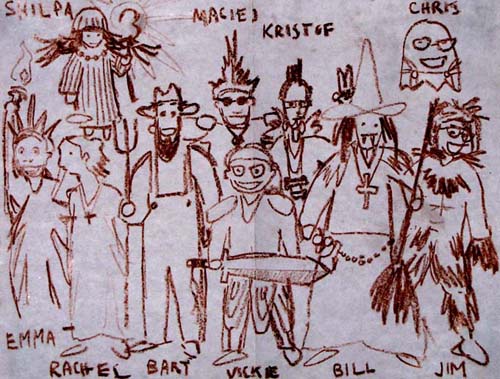
Seriously, who would get on an ATV with that guy??
(Halloween drawing of the team, by Chris!)
4 November 2009
So far, I haven't spent a great deal of time talking about our project, because I feel the three other blogs that I have linked to here are covering that in detail enough. However, for anyone following along for the first time (and after all, this is my first time in the field getting actual data, not just testing) I thought it would be a good idea to give a basic overview of the project, and I've now put up a page with that goal in mind. Then in the future as I do talk about the progress of the project, hopefully it will make sense.
This week so far we have had a lot of not-so-technical setbacks, and we have yet to get a single mission run. The primary challenge so far has been getting our melt hole large enough for the bot to get through. There's an art and a science to melting a hole through 15 feet of ice, and these guys that spend every summer season down here have it down. However, they rarely melt a hole as big as the one we need, and the one time they did it before (last year) it was a full month later in the summer season, and it was quite a bit warmer. Now, not only is the ice colder and harder to melt through, but the water is refreezing faster, closing the hole some the minute heat is removed. Several setbacks with fuel and equipment disrepairs (and a small fire!) added to the heartache. However, once we were finally to the point we thought we could proceed, the first order of business was not, in fact, to send the robot down, but to send a human. Yes! Luxury diving vacation, this. Bill and Vickie jumped through a lot of hoops to be allowed to dive in Antarctica, and it has finally paid off.
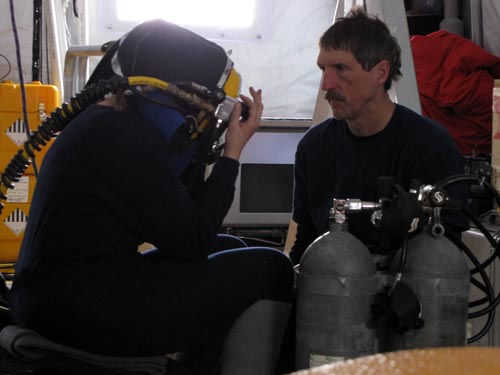
Bill helping Vickie into her copious amounts of cold water dive gear. Here she is testing out her air supply as well as the communication link in her dive mask. She will have constant communication with us on the surface, and unlike traditional scuba, her air tanks will remain at the surface due to the extreme temperature.
The reason Vickie is taking the plunge is mainly because of the fragile fiber optic cable that will be linking the vehicle to mission control. This cable is very thin, and the only link we have to the vehicle in case of problems. This cable will continually be rubbing against the walls and bottom edge of the hole, and if there are any sharp edges or obtrusions where the line can get caught, this could mean the loss of our only communication link, as well as a very expensive cable. So she went down not only for inspection, but also for correction. At some point the ice axe was lowered down, and chipping away she went. Imagine wielding an axe in almost zero gravity. Not very effective, but plenty tiring! So that was kept to a minimum, and placing the melters in better locations was the primary goal.

Vickie getting lowered into Lake Bonney with the help of the gantry hoist. She is now officially the first woman to ever dive in Lake Bonney!
Now hopefully tomorrow gives us a robot in the water!
7 November 2009
This season has been fraught with challenges, and until lately, I had thought them to be due to my lack of experience with all things Antarctica, and long-term field work in general. For certain, many of them have been the product of this. Amongst the many things I've learned since my arrival:
- Don't go camping with a Temperpedic pillow in Antarctica. I could get arrested for assault if I used that thing in a pillow fight, but sleep on it I cannot. (Temperpedic freezes.)
- If you can't cut a chicken breast with a spoon, you are not hungry enough.
- Don't rummage through cardboard cases of sodas or beers too quickly, or you will throw rocks all over your coworkers' dinners. (Helicopters just drop these loads in the rocks outside camp.)
- People still drink Tang. Some of them, lots of it.
Etc.
However, the past few days have been hard no matter the perspective. The constant setbacks from the weather delays, ice melting struggles, and other little things like our not-so-long forgotten fiber optic cable termination issues have added up, and put us quite a bit behind schedule, and our time here is already defined. The season is over December 4, regardless the use of our time. Determined to make up the time, we scrubbed all our weekends off back to McMurdo Station. We made a more ambitious schedule for all our data-collecting missions. We began, somewhat subconsciously, working 12-hour days. We're not taking breaks, even lunch breaks. Our food tent has dwindled down to bits and pieces. Today I had cheese for lunch as I worked, until I saw that Chris was hording raspberry preserves in his corner. So then, cheese and jelly. Tension is a constant companion during our work days now, and even light humor seems to fall on deaf ears, and at the worst possible time: as we are finally able to begin running missions and collecting data.
We get started Thursday, on a path to begin our own first runs through the lake to calibrate some sensors, to an array of our very own problems that resulted in opening one of our waterproof pods. This is not a quick process, requiring lots of unbolting and the use of the hoist, and lots of care with o-rings, etc., not to mention any of the actual work being done with the electronics inside. That problem solved and half a day lost, we get some calibration runs done, then start out fresh the next morning. Finally on our first real mission, we quickly begin having problems - the fiber optic cable is getting snagged on unknown obstacles under the ice. This happens once, and after several time-consuming strategies, we decide to pause the mission, and retrace our steps. This works, but time is lost. We continue on. Happens again. Time lost. Happens a third time, and losing time to double back, we end up with another snag, two at once. Just for reference, I'm pretty sure the cable became snagged twice all last season. We hit four in one day. We managed to get that solved, put together a few more data points to get on our dwindling battery power, only to be hit with another unrelated problem, and, as I write this, we are still not sure what happened. Let's just say the day was over, and we're coming in a few hours later tomorrow to make up for our midnight dinner this evening.

The pod in question, the contents of which run the thrusters on the vehicle, is open here. Chris looks on. (Photo credits to Kristof)
Leaving the bot house on our latest drive home to date, it was quite a bit dimmer than I was used to. I expected this, as the sun was going down behind the mountains to our south. But what I didn't notice immediately was the thorough cloud cover. And what a drastic difference that made to the mood of the scenery outside. For the first time, or so it seemed as I looked on, everything looked really cold. Here are some pictures I took after our late return to camp.

Hughes Glacier, behind camp, bluer than I'd ever seen it.
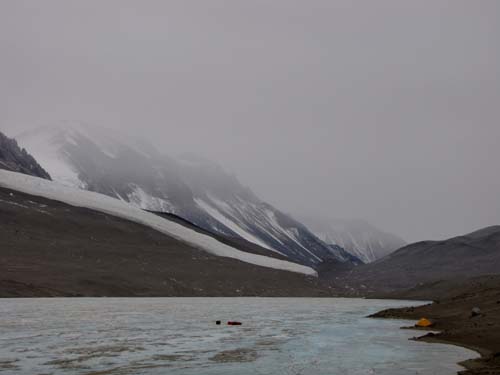
Looking down valley, into the clouds. John Priscu, who has spent 25 summers in Antartica, likes his tent right there on the lake. Sure does look cold, although despite the appearance, the evening wasn't particularly colder.

Something about this scene made me feel more like I was on another planet than any one yet. The bot house is just on the other side of the hill, called Bonney Riegel.
Spending our half hour trip home in this newly stark environment somehow put the challenge we have ahead of us in perspective. Guess it was never meant to be easy. We wouldn't be here if it was.
10 November 2009
Snow! That'll fix all our problems!!

Yay snow! Being Texan, this was an exciting thing to wake up to Sunday morning. The Dry Valleys get very little precipitation, so by growing up in Dallas I likely saw as much yearly as they get here. So, worthy of some excitement.

Even the non-Texans got into the fun. Here's Kristof sliding around the moat ice while waiting for everyone to get situated on the ATVs for the commute to the bot house. A snowball fight ensued later.
It indeed fixed our problems, that and lots of troubleshooting Sunday afternoon. When Monday came, those problems were solved. After all was said and done, we got more accomplished in one mission than in any single mission last year, thanks to the new extended life provided by our new batteries! Monday was very long, however, and we left the bot house well after midnight. We decided upon our return home that we needed to take Tuesday off, and decided to watch a movie, even though it was very late. I had The Big Lebowski with me, and Chris started passing out white russians. Guess it's about time to have an ounce of relaxation.
I spent my day off, for the most part, getting much needed sleep (although I did take a little time to get more pictures of camp). Good thing, too, as we started plenty early today, back at the bot house. Before we could get started with the day, we had to do some camp maintenance. We are now officially down to zero, yes zero, Hotsies, and our melt hole is slowly getting smaller as a result. We have five on order from McMurdo, which is considered overkill by all in town, but at the rate that we've been losing them, it just may get us through the rest of the season. In the meantime, however, the two dysfunctional units had to go back. The helo arrived for them about 10am, and we had just gotten them strapped into the net. Here's some video I managed to catch at the last minute, as John Priscu was attaching the load cable to the helo.
The rest of the day was spent troubleshooting some more problems, and we are all beginning to think that we have moved well beyond Murphy's Law into good ol' fashioned cursed. Hopefully tomorrow will not only see us getting the electronic goblins out of the communications system, but also moving on to the - dare I say it - next crisis. Wish us luck.
13 November 2009
Friday the 13th. Not usually an unlucky day for me, and after the week we've had, it really could only get better. This was definitely true, as we got our longest mission to date done today, without a hitch. We fed out over a kilometer of fiber optic cable, and didn't get it snagged once. Excellent. We even made it home before dark. (Hahaha!) But seriously, we only worked twelve hours today, which is a short day here lately.
The biggest downside to the day by far was the weather. This is disappointing on a couple of levels. For one thing, for the first time last night, it was above freezing! 36F we noticed during dinner! Today, it continued to be warm but... the katabatics arrived due to a low pressure system on the coast. So today we could not enjoy the new warmth. On top of this, just the logistics of working in the wind. It was blowing into the exhaust pipes of the heaters at the bot house and blowing the pilot light out, keeping us very cold inside. The walls were flapping so hard we couldn't hear each other talk. Even a couple of the nuts that hold the plastic windows on randomly flew off. The valley-wide internet repeater has been knocked out as well, and we will likely not have internet back up until at least Monday. I have no official word on the highest wind speed for the day, but the highest observed in real time was only 35 mph. I'm pretty sure this is not the best we did though. Despite all of this, the work day went well.
After dinner, John mentioned that the "purple tent up the hill [pointing in the direction of my tent] looks like its fly is loose and about to fly away." Well that had to be me. So I decided to head out early to assess the damage. I got about halfway up the hill, and it was clear my tent was fine. Looking further up the hill at "tent city", where Shilpa, Chris, and Kristof have their tents (and there is a fourth empty tent), I could see chaos in two directions. Hmmm...
I returned to the jamesway. Kristof: "Your tent? Need help?" "Um... no. It's not my tent. Do your tents maybe have purple bottoms? I'm pretty sure two tents are completely uprooted." In ascending order of damage...

Here is Chris's tent (left, obviously).

And, here's Shilpa's tent. Oh, sigh.
Kristof was right behind me on the way back up the hill, and the two of us ran around the windy, sandy hillside collecting randomly strewn clothes of Shilpa's. Shilpa and Chris were meanwhile getting their boots, etc., on. The wind had thankfully died down to about 20 mph at this point, which was good, but who knows how far things may have gotten. Hopefully Shilpa can do an inventory soon, and we can all make an effort later to find anything else. We had a spare tent, and the whole team pitched in to help erect that for Shilpa, and to help Chris put his back together again.
Guess this leaves the results of Friday the 13th open for interpretation.
14 November 2009
If we thought that yesterday was a great day, and if we thought that having snow was great, then today must have been awesome. We successfully explored the farthest reaches of West Lake Bonney, feeding out almost 1.5 kilometers of fiber optic cable without a hitch, and then after that, we got this:
So much for no snow in the Dry Valleys. We're all guessing that we got the entire predicted yearly snowfall today alone. But today was not all fun and snow. It was another long day, about 16 hours, and we didn't return home until after midnight. On top of that, the storms and winds continue, and as I write this not only is the internet out, but we have lost our phone as well. All communications are by VHF radio now. We are just about to run out of food for meals, and ordering from McMurdo food supply by radio will be tricky at best. Making things more complicated is the fact that we have eight LTER people joining our camp (essentially doubling our person count) on Monday, assuming helo flights are able to resume.
Despite these things, all were in good spirits. We determined that we had made enough progress to take tomorrow off, and a celebratory snowball fight broke out almost as soon as we returned to camp. It's not a real Engineer Snowball Fight unless someone says something like "trajectory" almost immediately. Check.
Possibly the slowest snowball fight ever.
15 November 2009
Today was a nice relaxing day, and I spent most of it to myself, reading about plants. I greatly miss plants, and I am making a concerted effort to fix my brown thumb. Not here, of course. Even keeping houseplants is very against the rules here. Although I am excited to see the official greenhouse in McMurdo when I get back. Chris told me they even have a hammock set up in there so you can provide yourself with some "plant therapy" if you need it. I just might.
When I did decide to rejoin civilization, or at least as much of it as exists here, I happened upon this unfortunate scene:

Chris had been talking snowmen last night. I'm disappointed that he didn't take my suggestion of snowbots, but this Calvin & Hobbes-esque scene is pretty good, too.
After a tasty dinner of almost-shepherds pie, I decided it was time for my first shower. Ah, life in the field. We are about halfway through our field season now, and many people used the opportunity of some time off today to have a shower. Showering here, as you might imagine, is somewhat of a high-maintenance affair. Some of you have probably seen a solar shower before, but I personally had not. Basically it's just a bag with a spout on it that you fill with water and hang roughly above you. Where "solar" comes in is that it is black on one side, so that it absorbs heat from the sun to warm the water a few hours prior to use. Well, that's not particularly effective here, since we are starting from glacier ice. So we heat our water using a more conventional method - the stove.

Here is the solar shower bag set up, to the left. We use one of the small berms to catch the water. The building we used for the shower room is one of the LTER labs, the green buildings on the lake-side of the jamesway.

To make the shower room extra festive, radioactive things! I have no idea what these contain, but I think I'll refrain from decorating my shower at home in Radioactive Nouveau.
18 November 2009
The last couple of days we have had very successful missions. We have in fact finished all of our official data samples of West Lake Bonney in much less time than last year, and even got sample points that were not acheived last year. This is great news, and it means we'll have plenty of time for our second and third priority items - mapping and imaging Taylor Glacier, and mapping the west lobe of Bonney itself.
Today, however, we added a new item to our list, at the request of John Priscu: going through the narrows between the east and west lobes of the lake. This required the use of almost our entire two kilometer cable, and all of the available power from our new batteries. The mission could not have gone better, especially considering the risk involved: any sort of power or communications failure that far out would likely have found us melting another hole to retrieve the vehicle, a time-consuming task that could have ended our season immediately. But we made it home with zero volts to spare, to a very happy team of scientists who now have bathymetry data they could not have gotten any other way. Here's a basic layout of Bonney with various locations marked for reference.
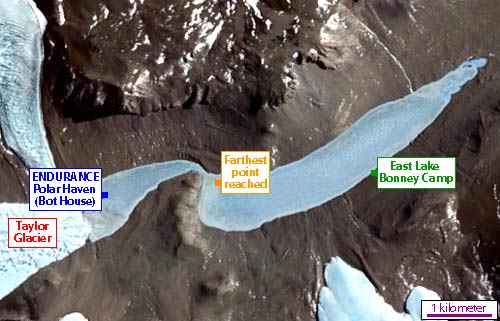
Meanwhile the logistics troubles continue to plague us. We have been without internet now for almost a week. Techs in McMurdo have made an attempt at a fix today, but nothing yet. Phones have recently been restored, however our large increase in camp tenants arrived Monday, bringing with them a thunderous clamor that had some of us looking for a quiet place to hide, and certainly no chance of a coherent phone conversation. In addition, we have been surviving so far this season with three ATVs. Two was usually enough, however 16 people in camp and four people per ATV, you can see an obvious problem. The first half of our team left yesterday about two hours ahead of myself and the rest, and when it came time for us to head out, a sitcom scene erupted at the exit of the jamesway, with two ATV gangs about to rumble. After some radio communications amongst the not-present leaders of the warring factions, we were de-prioritized.
Shilpa and Chris decided to wait for another ATV to return, but I decided I was going to make the hour-long walk to take some pictures of the scenery I'm always hastily passing. It was a very nice day yesterday, considering what we've been through lately, and I decided to take a "short cut" across the rough ice of East Lake Bonney. This turned out not to be a short cut at all, as the ice on the east lobe is definitely rougher than that on the west, with some of the ablations in the ice being high enough for me to have to go around as opposed to just crossing over. The warm weather lately is adding to this for certain, as well as to the large amounts of streams and ponds that are cropping up in the lowest spots in between. Despite the challenge, it was an excellent walk, and the pictures I had planned to get paled in comparison to the surprise opportunities I got along the way. The following pictures do not duly represent these structures; hopefully I can explain in words what may not be obvious in each photo.

This is one of the first really extreme ablations I encountered on my journey. This thing is over a foot tall, and straight up! I'd hate to hit that on an ATV. You can probably also see some of the shorter spikes around these formations. The ice is extra slippery now that it's warmer, and falling on one of those would be a bad end to my day. I tried to avoid those areas during my walk, but I got blocked in on more than one occasion...

This is the only one I saw like this, with a cave forming underneath. It's about a foot and a half tall at this point.

The higher regions begin melting before the rest of the lake ice, I'm assuming because they have lots of air trapped in them. As they melt, these very strange formations begin to form. The skinny guy to the left was almost a foot tall and no more than a half-inch wide on the thinnest edge.
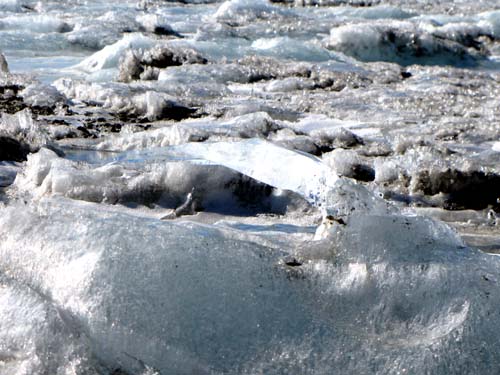
Believe it or not, this is most of the reason I decided to take the hike. Of course it has been eclipsed by these other formations, but this ice arch (which has melted significantly since I first saw it many days ago) was visible from the moat ice that we commute on every day. I had no idea the others were here until today.
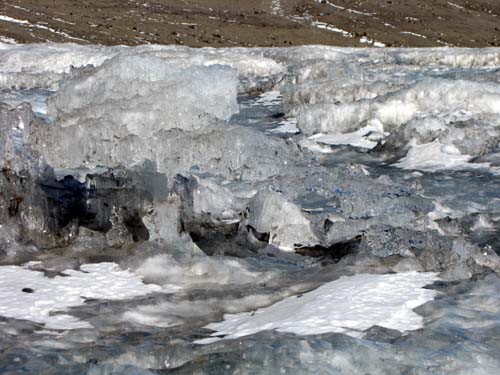
This, though, was the most spectacular thing I saw on my entire journey. If you can't tell in the picture (and it's hard to see) the large bridge of ice seen in the center is not actually a bridge. At least five feet of ice is cantilevered out. At its tallest, the support on the left is about three feet tall.
After spending a good portion of yesterday hiking around in this cross between Superman's lair and a minefield, it might be hard to convince you that today we had not only an environmental inspection, but a safety inspection, and in the middle of preparing for those, we got a few minutes notice of a surprise visit from the board of directors of NSF, who just happened to be choppering their way to the bot house! This news sent us scurrying off in the middle of breakfast to make sure we were there to meet them. And on the way home, we even hit a pothole. Sometimes you can't travel far enough to get away from the trappings of modern society.

The "pothole" we hit in the moat ice on the way home.
But we still can't get internet.
20 November 2009
Today I am finding out that I am not a huge fan of celery salt. I don't think I've ever had celery salt before. It was the only salt-type condiment I could find with a lid on it to travel with me to the bot house to put on this cold, plain macaroni that I'm having for lunch/dinner. Just thought that everyone would like to know that.
In more technical news, today we did something completely new to the robot: gave him a few hundred pounds of baggage. Our plan to explore the area around Taylor Glacier over the next few days has several facets, and our plan on Monday is to go to new depths - 21 meters. So far our transit depth around the lake has been no lower than about 6 meters below the ice. Peter and John want to go deeper than this near the glacier, however, which is a complicated issue for a submarine vehicle without a variable buoyancy system. Lake Bonney has an interesting feature known as a chemocline (and halocline) at about 15 meters. It is fresh water above this point, and below this point it is salt water, about four times as saline as sea water. This means that when we ballast the robot to be neutrally bouyant at 6 meters, it will just sit on top of the sea water when it gets to that depth. So Bill has come up with an elaborate (or not-so-elaborate, depending on view) system to allow us to add 240 pounds to the robot: ropes and dive weights! With this weight the bot is more or less neutral at 21 meters, but we had to do some testing at the melt hole today to arrive at that exact weight.

Here's the robot before the buoyancy tests with his fashionable handbags. In this photo, the bags actually contain a total of 300 pounds, our starting estimate for the weight required. 300 pounds actually put us neutral at about 27 meters - the water gets more saline as it gets deeper.

Getting it down to the chemocline is a piece of cake. Getting it back up is not. Here, Bill and Jed, I mean Kristof, haul it up slowly using a system of pulleys. Keep in mind they are only having to pull up the weight of the dive weights. The bot itself is buoyant in the fresh water above the chemocline.
This may seem like a lot of physical labor for science. Well, it is. But not as much as it probably appears. Today this had to be done for the buoyancy testing. And we'll only be doing it again to explore the glacier. Going below the chemocline is something we had to be given special permission to do, for the purposes of studying a point near the glacier of particular interest. (And if deemed safe, worth the data, and even possible, we may also swim beneath the glacier!) Something the size of our vehicle passing through the chemocline is very disruptive to the stratified layers in the water, which is why when we sample the water chemistry, we must drop a much smaller device with all the instruments attached. Here is a short video I took of us checking the science package above the melt hole in the bot house, complete with overly dramatic soundtrack.
Before Monday, however, our plans are just to explore the face of the glacier and get more data about the water chemistry as well at the geometry of the glacier face. This is good information to have before getting ourselves into deeper water later, but in addition should be a very exciting mission in itself, with lots of great images, either in actual photos, or in sonar mapping imagery. Stay tuned!
23 November 2009
Since we have lately ceased to spend almost any of our waking hours at Bonney Camp, I thought now would be a good opportunity to provide you with a brief tour of our home away from home away from home.
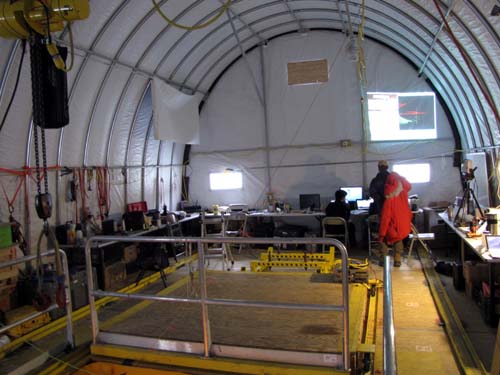
The length of the interior of the bot house from the entrance, as it looks during missions. The bot sits on the yellow sled (center, back) when out of the water. That area is a much more crowded and busy place before and after missions, while we each tend to our pre- and post-dive duties.

Here's a close up of mission control. A projector displays information most pertinent to the mission and the vehicle status, the most notable in the photo being the visualizer display. This is a real-time graphic display of the physical environment as seen by the sonars on the vehicle.
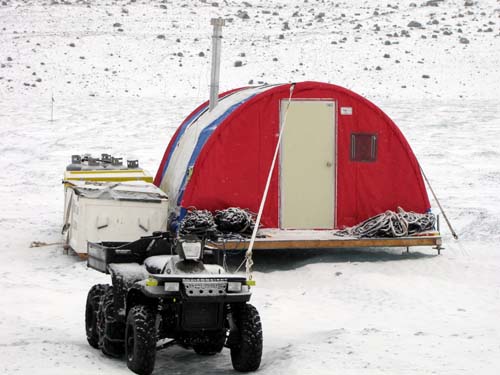
This is our kitchen polar haven (which the carpenters labeled "The Nightclub" - I often refer to it as "The Disco"), containing not much more than a coleman stove and some tables. It's just a few yards away, but I don't often have time to walk even this far to eat, and at this point it seems to be used for equipment storage as much as eating.
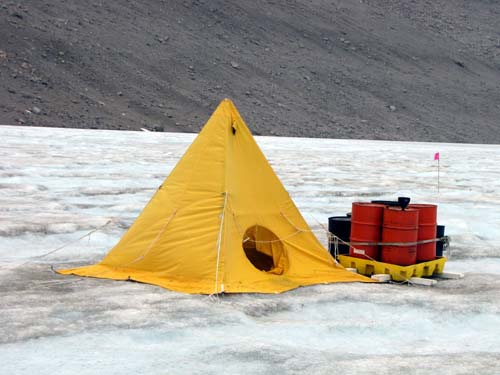
And here's our fancy bathroom, the scott tent. Attempts at crawling through that small hole while wearing a puffy parka in 40 mph winds without slipping on the ice are often successful, with maximum effort. Some of the guys decide to go directly to the funnel in the urine barrel (right). Let me reinforce that the wind almost never stops blowing here.
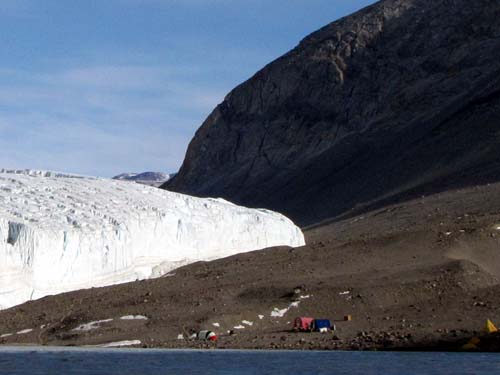
This is the shore just north of Taylor Glacier. The camp you see there is Blood Falls Camp, which is not a permanent camp, and is where the ENDURANCE team stayed last year. This year, another research group had dibs on it, which is why we are staying at the permanent East Lake Bonney Camp.

Here's a close up of the Blood Falls portion of Taylor Glacier. Last spring, CNN did a story about some of the research going on here.
26 November 2009
Happy Thanksgiving everyone! I had forgotten today was Thanksgiving, actually, until some thoughtful folks sent me online greetings, when it was still Wednesday in the US. I am thankful for the two hours of working internet we had today!
Today didn't feel like Thanksgiving otherwise, and it was a long work day as usual. Today I spent a portion of my day helping out at our new (yet as I type this, already retired) melt hole out by the glacier. This second hole was melted so that the robot could surface near the glacier for us to add the weights to submerge it to the depths below the chemocline. Doing this here allows the smallest amount of travel at those depths, and less disruption of the stratified layers within the lake. Missions from this point included a rope line tied to the vehicle, so that it could be hauled back up with its hundreds of extra pounds. Having a rope attached in addition to a fiber optic tether is a potentially disastrous situation which could result in tangled and snagged lines, and we brought divers out from McMurdo in case there was a problem, or in case we decided to go without the rope, so that they could dive and re-attach the line to haul the vehicle up.
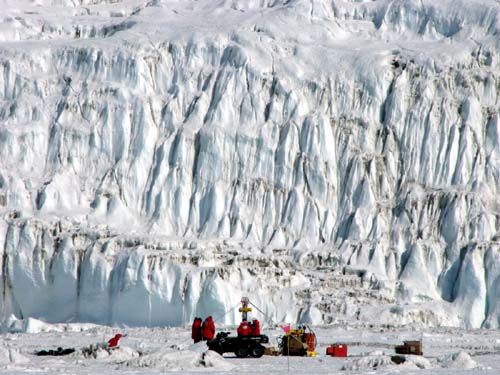
Taken from the from door of the bot house 400 meters away (thanks new camera!), this shot was taken just as the bot was surfacing, as our crew and divers look on.
As it happened, everything went flawlessly, and the divers got a relaxing couple of days in the field. The rest of us, though, had work days as usual, and several of us got plenty more than that. Installing hundreds of pounds on a vehicle in a hole in the ice is no normal day for most people, even for us. It was a blustery day on top of things, and we stayed cold and slightly wet for a lot of it.
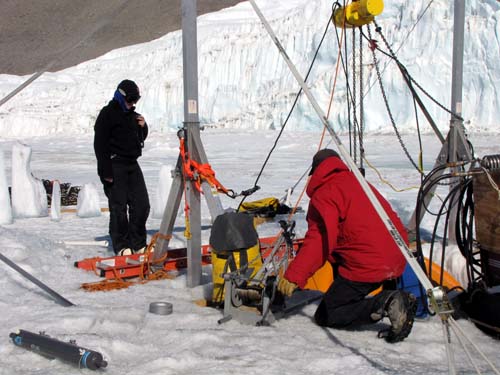
Here Vickie is watching as the bot does a chemistry profile at the melt hole, after which she and I will install its extra weights. Meanwhile Peter is capturing water samples to be further analyzed back at the Crary Lab in McMurdo.
The water sample Peter is taking here happened right as a helicopter was landing to pick up the divers. This opportunity had Peter chasing off after the helo in an ATV in a very movie-worthy fashion, so that the lab in town could get the sample as soon as possible. Lots of excited yelling and flying hats ensued amidst the rotor wash, and we felt like we were getting to do Hollywood-level science, if but for one afternoon.